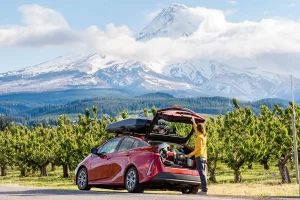An all-wheel drive or 4-wheel drive vehicle can be an invaluable asset to drivers living in regions with harsh road conditions, but not all models of such cars are built equally.
AWD systems provide power to both axles as required, shifting power between them when slippage occurs. To best handle adverse weather conditions, the most advanced models combine AWD with additional features like hill descent control and X-Mode traction management for optimal performance.
Snow
Under snowy and icy conditions, AWD vehicles help drivers maneuver out of parked car jams more easily in parking lots or navigate unplowed roads more safely while also helping them accelerate more smoothly on slippery surfaces. Furthermore, these vehicles help drivers maintain momentum on steep hills or snowy terrain where braking or steering might otherwise become challenging.
Drivers looking for optimal snow traction should equip their vehicle with winter tires. Even the latest all-season tires provide less traction in snowy conditions than AWD vehicles equipped with winter tires; many drivers often underestimate braking and cornering power in such conditions.
All-wheel drive systems such as Subaru’s Symmetrical AWD system offer excellent road grip and vehicle control on ice and snow. Unfortunately, however, this technology cannot overcome unsafe driving habits; many states mandate chain use on mountain passes – Les Schwab recommends checking your owner’s manual to learn of such requirements in your state.
Rain
AWD vehicles are an ideal choice for people living in regions prone to rain and ice. AWD makes a significant difference when driving in difficult road conditions as its engine can power all four wheels simultaneously when needed, giving greater traction. All-wheel drive systems employ sensors to analyze road surface conditions and vehicle dynamics, and distribute power between axles and wheels in order to maximize traction. Furthermore, AWD/ 4WD systems help drivers avoid hydroplaning – an effect in which vehicles lose contact with the road surface – by spreading power evenly among axles and wheels for maximum traction. However, AWD or 4WD does not stop vehicles any faster than 2 wheel drive, therefore drivers should still exercise caution in these types of road conditions; speed is the leading cause of hydroplaning.
Ice
AWD vehicles excel at maneuvering through snowy roads when equipped with winter tires. AWD sends power to all four wheels at the same time, giving it more traction on slippery surfaces than front- or rear-wheel drive vehicles do.
Edmunds notes that driving on ice requires drivers to adapt quickly to rapidly deteriorating road conditions as soft snow quickly turns to hard-packed ice, then to glare ice. AWD and 4WD systems that deliver power continuously to all four wheels or automatically engage them when needed are most capable of adapting to these ever-evolving road conditions.
While AWD and 4WD cars may accelerate more quickly in snowy and icy conditions, drivers still bear responsibility for stopping, steering and braking their vehicle safely. Over half of weather-related car accidents involve drivers losing control while accelerating; having the appropriate drivetrain and winter tires will help prevent you from becoming one of these statistics.
Dirt
Instead of sending equal amounts of power to each wheel, AWD distributes it where it’s most needed – making it great for dirt roads and light off-pavement excursions in mild snow conditions. However, for serious snow conditions or serious off-roading expeditions 4WD vehicles with sufficient ground clearance should be used instead.
Unfortunately, many drivers tend to be overconfident when it comes to driving in inclement weather and poor road conditions. They assume that as they have an all-wheel drive vehicle they can simply accelerate to their speed limit as soon as weather worsens – an error which could potentially cause accidents. This mistaken approach should be avoided at all costs to prevent potential mishaps from occurring.






More Stories
Road Trip Essentials – What to Pack for a Long Drive
The Age of Auto Accessories Supporting the Environment
The Importance of Regular Auto Maintenance for Longevity